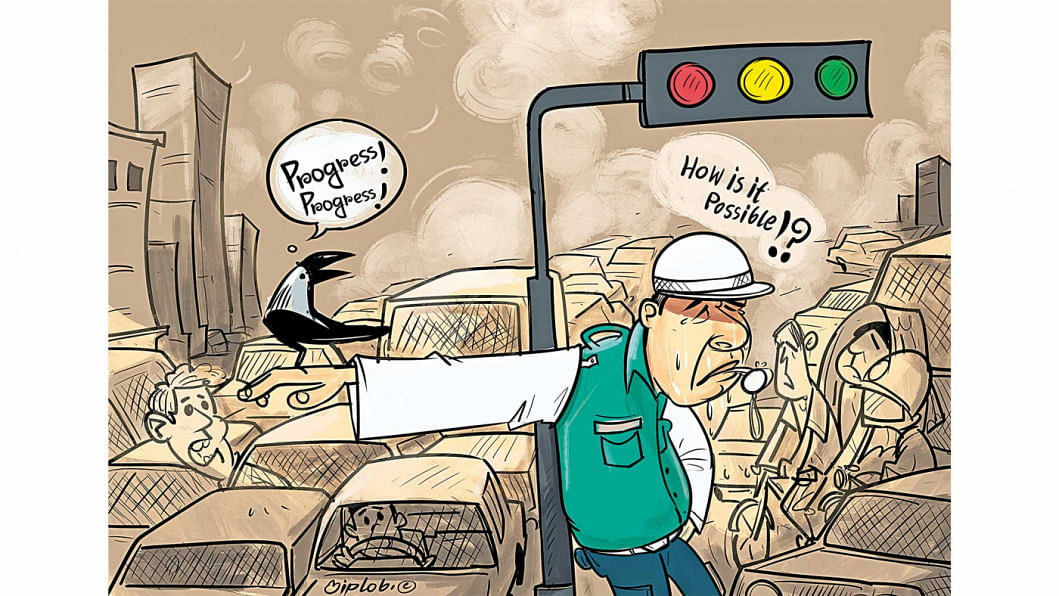Can traffic get any worse than this? Yes, it can.

Why is it that, no matter how many times we have experienced something unpleasant, we continue to do the exact same things we did before, expecting a different outcome? This illogical perspective that is described as insanity cannot be more manifested than in our traffic situation. Before Ramadan, it was bad enough. Travelling from A to B took a minimum of one hour no matter what the location, whether it was from Kachukhet to Gulshan or Gushan 1 to Gulshan 2. Now, with the holy month in progress, public office goers are out by 3 pm, people are already shopping for Eid, and schools have reopened, making an already untenable situation worse.
Dhaka is at a total standstill, most of the time. We hear of school students arriving an hour late for class or commuters from Uttara spending two and a half hours on the road to reach Karwan Bazar, making their total number of travel hours (up and down) around five hours—every day, except maybe Friday. One cannot but reiterate the refrain: How are we to function if we spend so much time just on the road? On top of that, it's hot and dusty thanks to perpetual construction, the air is thick with choking smog—why must something as basic as travelling within the city be such a miserable experience? What happens when there is a medical emergency, how will an ambulance reach the hospital on time before someone's breath runs out?
With most of our energy sapped from being trapped in traffic, we are washed out by the time we reach our workplace, irritable and demotivated, especially because we are already thinking of the gruelling ride back home.
They say that once the metro rail is complete, all problems will be solved. Yes, they could be, to an extent, if most people decide to use the train, especially private car owners. The question is: Will they? And what do we do in the meantime? There are over three lakh private cars plying our roads currently, taking up 60-65 percent of their capacity. How can we get a large number of these vehicles off the roads?
Reducing the number of private cars and motorcycles would be an obvious solution. What about taking off CNG-run private vehicles from the main roads of Dhaka? This is no doubt a controversial suggestion as it will hurt the middle class who can now afford private cars because they are CNG-run. But if people had safe, clean, easily available, and properly-driven buses to use, maybe they would be persuaded to leave their cars at home. And when the metro rail finally arrives, the benefits of a large majority of people using it, even some of those who would otherwise be napping in their fancy fossil fuel-run SUVs, would be huge. As for school-goers, if there were enough safe, reliable school buses, the unnecessary jams near schools could also be avoided.
The bottom line is that policymakers must wake up from their slumber and come up with real solutions instead of keeping their eyes closed as their flag-flying cars whiz by while the rest of the population sweats it out in the chokehold of traffic. They must repair the footpaths (so people are not maimed by open manholes, potholes and broken debris from construction) and free them from hawkers who have to pay a fee to the local mafia for a piece of pavement. Many people have already resorted to walking instead of being stuck in hours of traffic, but the broken and encroached upon pavements make it hazardous and difficult to travel on foot. Public transport vehicles must be dramatically increased—we only have 37,593 registered buses for a city of over two crore. Our city fathers, moreover, must give up their indulgence of rickety murir tin buses, owned by powerful quarters, that emit black fumes and stop anywhere and everywhere to pick up passengers. Women in particular must be able to travel without fear whether on a bus, metro or on foot. Though experts have suggested adding widely available women-only buses, all modes of public transport must be made accessible to women.
There are also ways to lessen the burden of people moving around in the city. The Covid experience has given us a logical solution: A hybrid model—with some days working from home and the rest in the workplace. Government offices that deal with processing documents digitally could adopt this model and make sure all applications can be processed online without disruption. Other offices where most or all of the work is done on digital platforms, too, could benefit from this—especially during Ramadan.
These are not difficult measures to implement and it is surprising that most of what has been mentioned constitutes the bare minimum that ordinary citizens can expect from their capital city. Dhaka's population is now around 22,478,000 and is estimated to reach 31.2 million by 2035. One can only shudder to think how Dhaka will cope with another nine million or more city dwellers, most of whom will be moving around the city at any given time. Will those responsible for this city finally take notice of our misery and allow Dhaka's arteries to flow freely again?
Aasha Mehreen Amin is senior deputy editor at The Daily Star.

 For all latest news, follow The Daily Star's Google News channel.
For all latest news, follow The Daily Star's Google News channel. 



Comments